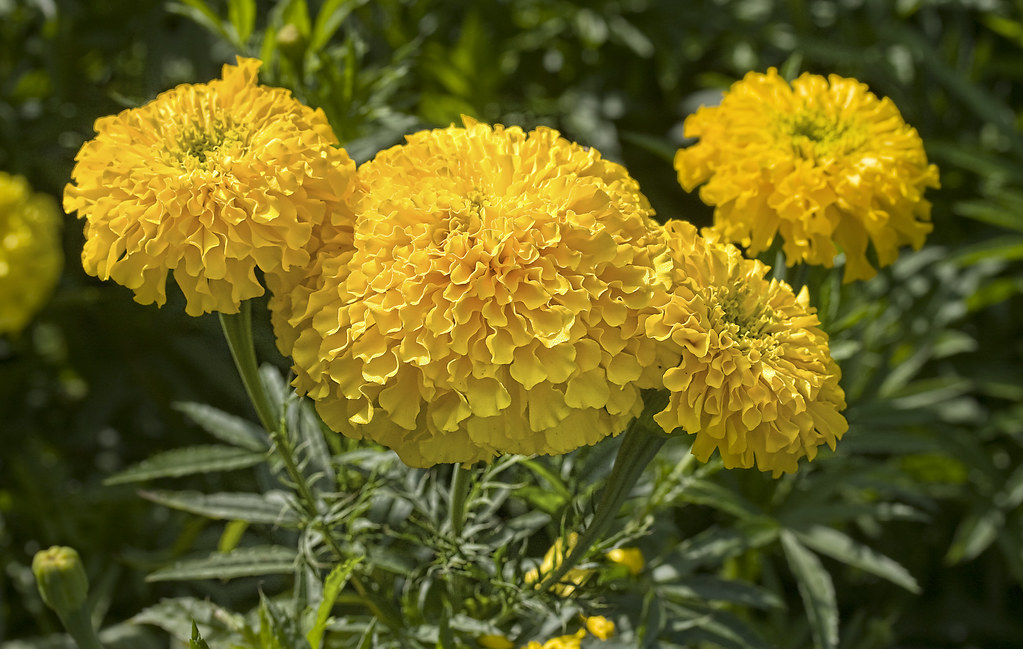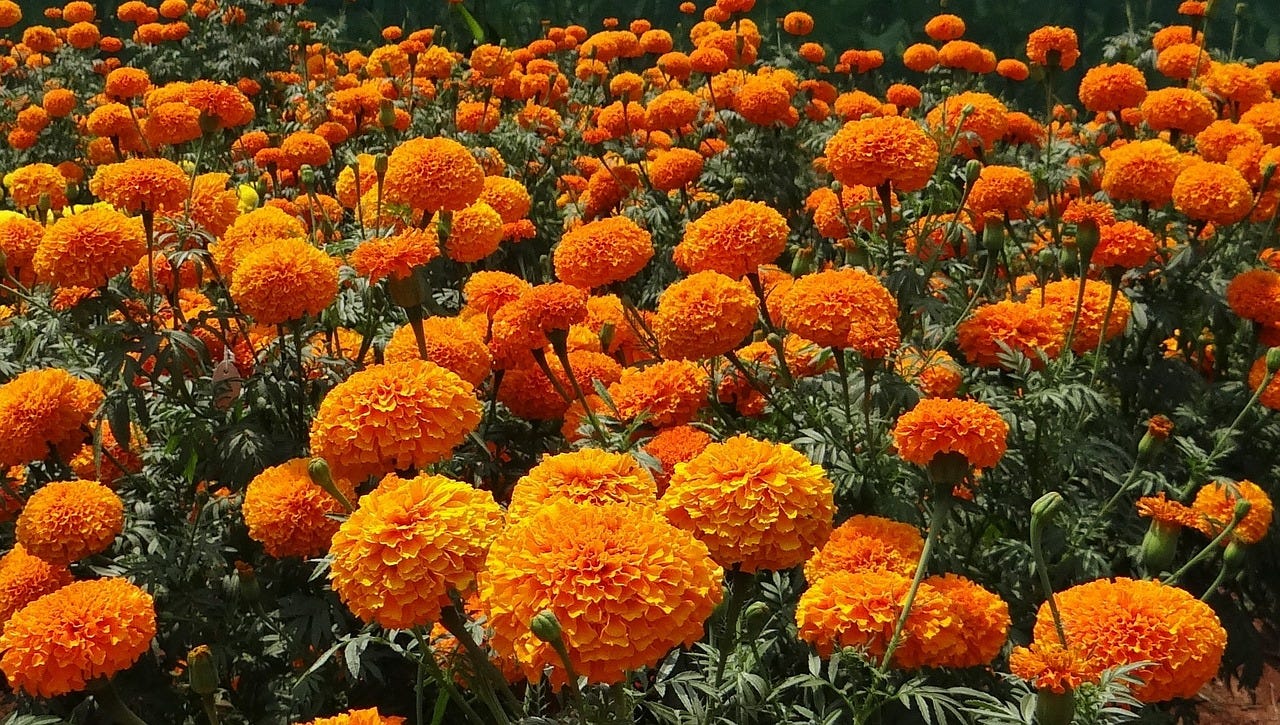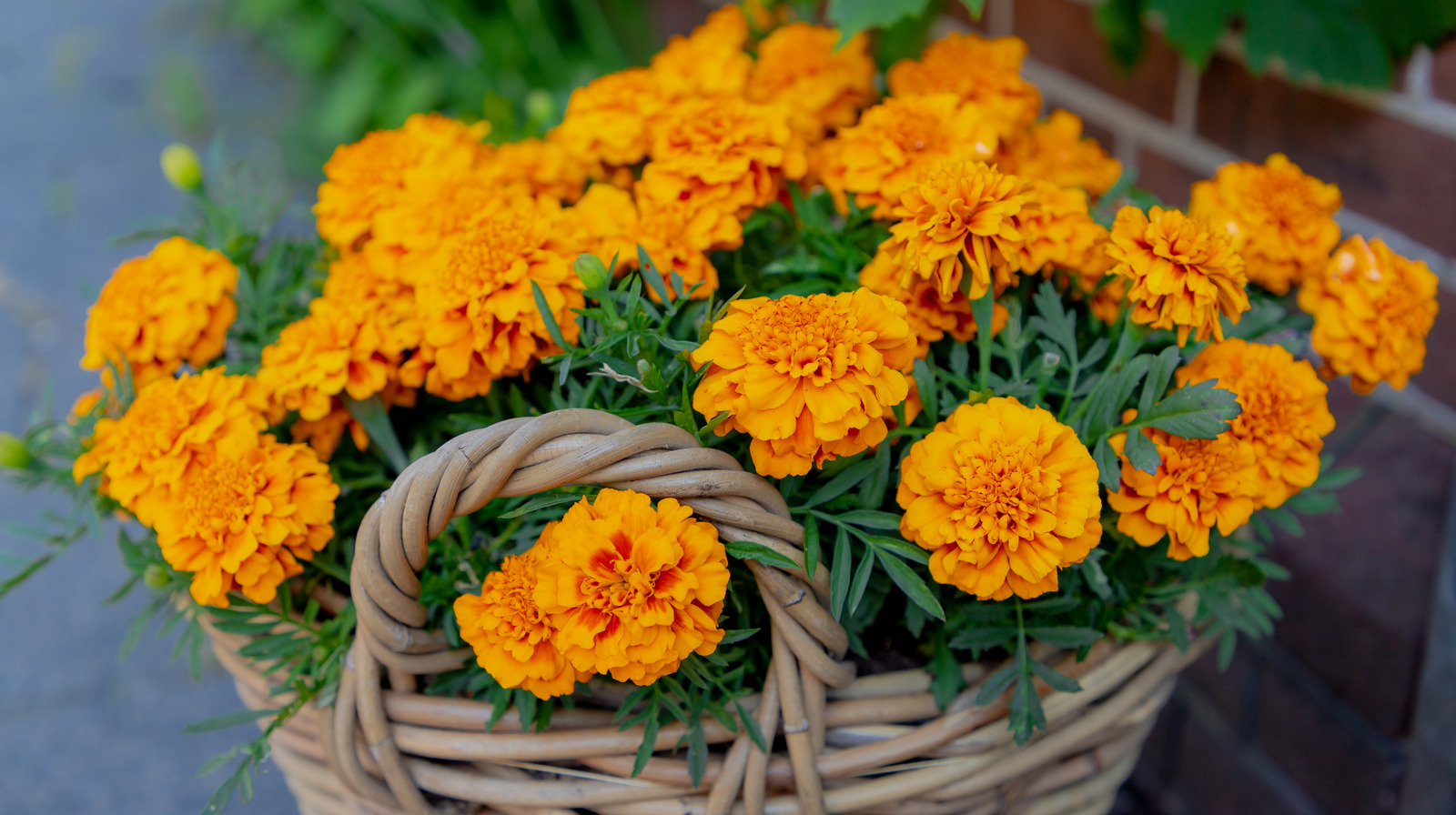Contents
Key Takeaways
-
Marigolds thrive in full sun and well-drained soil, making them perfect for most gardens.
-
There are various marigold varieties, each with unique benefits, such as pest control and vibrant blooms.
-
The best time to plant marigold seeds is after the last frost, in warm soil.
-
Marigolds need consistent watering and occasional fertilization for optimum growth.
-
Companion planting with marigolds can protect your vegetables and enhance your garden’s ecosystem.
Discover the Vibrance: Marigolds in Your Garden

Marigolds are not just a splash of color in your garden; they’re a beacon of joy and a fortress against pests. These bright and hardy flowers are a gardener’s best friend, offering a symphony of colors and benefits. Let’s dive into the world of marigolds and learn how to make them the stars of your garden.
Choosing the Perfect Spot for Marigolds
First things first, let’s find a sunny spot. Marigolds are sun worshippers, and they need a good 6 to 8 hours of sunlight to flourish. Look for an area that’s well-drained because these flowers don’t like wet feet. Once you’ve found the perfect location, you’ve set the stage for a show-stopping display.
Now, you might be wondering, what if my garden gets a little shade? Don’t worry. Marigolds are adaptable and can handle a bit of shade, but remember, the more sun, the more blooms.
Consider the height and spread of the variety you choose when spacing out your marigolds. This will ensure each plant has enough room to grow and won’t be fighting for sunlight or nutrients.
Understanding Marigold Varieties and Their Benefits
Marigolds come in a palette of gold, orange, yellow, and even red hues. But it’s not just about looks; each type has its superpowers. The African marigolds are tall and perfect for borders. French marigolds are more compact, excellent for edging and container gardening. And if you’re into something a bit different, the Signet marigolds offer dainty, lacy foliage with petite flowers.
But there’s more. Marigolds are known for their ability to repel garden pests, making them an excellent companion for your veggies. They can even help fend off nematodes in the soil!
Starting Your Marigold Adventure

When to Plant Marigold Seeds
Timing is key. You’ll want to start your marigold seeds after the last frost when the soil is warm. This usually means waiting until late spring or early summer, depending on your climate. Planting marigold seeds at the right time ensures they get a strong start and a longer blooming season.
Soil Preparation for Marigold Beds
Marigolds aren’t picky about soil, but they do their best in fertile, well-drained ground. So grab a spade, and let’s get digging. Turn the soil about 6 inches deep and mix in some compost to give your marigolds a nutrient-rich home. This will help with drainage and provide the nourishment they need to grow.
And don’t forget to test the soil pH. Marigolds prefer a neutral pH, but they’re adaptable. If your soil is too acidic or alkaline, amend it accordingly to hit that sweet spot.
Sowing Tips for Maximum Germination
When it’s time to sow, sprinkle the seeds on top of the soil and lightly cover them with about an eighth of an inch of soil. Keep the soil moist, but not soggy, as you wait for those little green shoots to appear. Marigold seeds typically germinate within a week in warm conditions, so you won’t have to wait long to see the fruits of your labor.
Remember, marigolds are best sown directly where they’ll grow. They’re not fans of being transplanted, so let’s give them the space to put down roots and thrive from the get-go.
Caring for Your Marigolds

Watering Techniques for Healthy Growth
Marigolds are somewhat drought tolerant, but for the most vibrant blooms, they’ll need a consistent supply of moisture. Aim to water your marigolds deeply a couple of times a week rather than a little every day. This encourages strong root growth. The key is to water at the base of the plant to keep the foliage dry, which helps prevent disease. If your marigolds are in containers, they may need more frequent watering, especially during hot spells.
The Balance of Sunlight and Shade
While marigolds love the sun, they can experience stress during extreme heat, especially in the afternoon. If you live in a region with scorching summers, it’s wise to provide some afternoon shade. This can be achieved by strategically planting taller plants to cast a shadow or using a light cloth to shield them during the hottest part of the day. Adequate sunlight is crucial, but just like us, marigolds appreciate a little respite from the intense summer sun.
Remember, though, that too much shade will result in fewer blooms and leggy plants. If you notice your marigolds stretching out and reaching for the light, it’s time to let the sunshine in. It’s all about finding that sweet spot where your marigolds can bask in the sun’s glory without getting a sunburn.
Nutrient Requirements and Fertilization
Marigolds aren’t heavy feeders, but they do enjoy a boost now and then. If you’ve amended your soil with compost before planting, your marigolds should be quite happy. However, if you want to pamper them, an application of a balanced, all-purpose fertilizer once a month can encourage fuller plants and more flowers. Go easy on the nitrogen, though; too much can lead to lush foliage at the expense of blooms.
Protecting Your Marigolds from Pests

One of the many charms of marigolds is their natural pest repellent properties. However, they’re not entirely immune to trouble. Occasionally, pests can take a liking to your marigolds, but don’t fret. With a little vigilance, you can keep your marigolds healthy and vibrant.
Most importantly, keep an eye out for signs of distress. If you see something off, act quickly to identify the culprit. Early intervention is the key to preventing a full-blown infestation.
Identifying Common Marigold Pests
-
Aphids: These tiny pests can suck the sap from your plants, causing the leaves to curl and distort.
-
Spider mites: Almost invisible to the naked eye, they can cause yellowing and speckling on the leaves.
-
Slugs and snails: They love tender marigold leaves and can quickly make a meal out of your plants overnight.
Keep an eye out for these pests, especially during the warm, humid months when they’re most active. Regular inspections of the underside of leaves and around the base of the plant can help you spot them early.
Healthy marigolds can usually fend off pests, but sometimes they need a little help. If you spot any of these unwanted visitors, take action. A strong blast of water from the hose can knock off aphids and spider mites. For slugs and snails, handpicking in the evening or setting up a trap with a shallow dish of beer can be effective. For more information, check out a pet owner’s guide to garden hazards to ensure your pest control methods are safe for your furry friends.
Remember, the use of chemical pesticides can harm beneficial insects and the overall health of your garden. It’s best to try natural methods first, as marigolds are all about promoting a healthy ecosystem.
Organic Pest Control Solutions
If pests persist, consider organic pest control solutions. Neem oil and insecticidal soaps are safe for the garden and effective against a variety of pests. Always follow the directions on the label and apply in the cooler parts of the day to avoid harming beneficial insects and to prevent leaf burn.
Boost Your Garden’s Health with Marigolds

Marigolds are more than just pretty faces; they’re garden workhorses. These cheerful flowers bring a host of benefits to your garden’s ecosystem. Their bright colors attract pollinators, ensuring that your vegetables and fruits are well-pollinated. But that’s just the beginning.
Marigolds release a substance from their roots that can deter nematodes, microscopic worms that can damage plant roots, especially in the vegetable garden. Planting marigolds as a cover crop in a rotating system can help reduce nematode populations and improve soil health.
Marigolds also have a strong scent that many pests find off-putting. Plant them around your vegetable garden to create a natural barrier against unwanted insects. It’s like having your own garden guardians.
How Marigolds Enhance Companion Planting
Companion planting with marigolds isn’t just folklore; it’s a tried-and-true gardening technique. Planting marigolds near your veggies can help in several ways:
-
They can repel harmful insects like whiteflies and nematodes.
-
Their strong scent masks the smell of your vegetables, making it harder for pests to find them.
-
They attract beneficial insects like ladybugs and lacewings, which prey on pests.
Imagine your vegetable garden thriving, with fewer pests and more pollinators, all thanks to the humble marigold. It’s a beautiful and practical addition to any garden.
Nematodes Beware: The Nematocidal Properties
Marigolds are not just for show; they have a secret weapon. Certain varieties, particularly the French marigold, have nematocidal properties. Their roots exude a substance that’s toxic to several types of nematodes, which can wreak havoc on your garden plants.
For example, a study found that planting French marigolds in between vegetable rows significantly reduced nematode populations and improved the yield of subsequent crops. It’s an eco-friendly and cost-effective way to protect your garden.
Therefore, if you’re planning a vegetable garden, consider adding marigolds to your plan. They’ll not only brighten up your space but also serve as a natural soil fumigant.
Marigold End-of-Season Care

As the season winds down and the first chill of fall is in the air, it’s time to think about end-of-season care for your marigolds. Deadheading, or removing spent flowers, encourages marigolds to produce more blooms and extends their display into the fall.
Once the frost hits, marigolds will succumb to the cold. At this point, you can pull them up and compost them if they’re disease-free. This will help keep your garden tidy and ready for next year’s planting.
And don’t forget to collect seeds from your favorite plants. Marigolds are easy to grow from seed, and saving your own is a cost-effective way to ensure a bright display for the following year. Simply remove the dried seed heads, let them air dry completely, and store them in a cool, dry place until it’s time to plant again.
With a little love and care, marigolds will reward you with a season-long show of color and vitality. They’re not just flowers; they’re an integral part of a healthy, vibrant garden.
When the vibrant blooms of marigolds begin to fade, and the cool air whispers the approach of winter, it’s time for gardeners to take a few final steps. Deadheading, the practice of removing spent blooms, not only neatens your garden but also encourages marigolds to produce more flowers. It’s like saying, “Hey, you’ve still got time to shine!” So keep snipping those faded flowers to extend the blooming period.
As the season truly comes to a close and frost starts to nip at the edges of your garden, marigolds will bow out gracefully. If they’re free of disease, add them to your compost pile; they’ll contribute to the circle of life in your garden, enriching the soil for next year’s plants. This is also the perfect time to play the role of a seed saver. Collect seeds from your marigolds to plant next year, ensuring another round of their cheerful presence. Dry them out, store them properly, and you’ll be all set for spring.
With these end-of-season rituals, you’ll bid farewell to your marigolds, knowing they’ve played their part well. You’ve fostered a space that’s not just a garden, but a vibrant, living tapestry that tells the story of growth, resilience, and beauty.
Frequently Asked Questions (FAQs)

Can marigolds thrive in containers?
Absolutely! Marigolds are quite versatile and can grow beautifully in containers. Just make sure you choose a container with good drainage holes to prevent waterlogged roots. Because containers can dry out faster than garden soil, you’ll need to water your potted marigolds more frequently. Keep them in a sunny spot, and you’ll have a mini garden that’s just as vibrant as one in the ground.
For example, a gardener in a city apartment might not have a yard but can still enjoy the bright colors of marigolds on their balcony or windowsill, bringing a touch of nature to an urban setting.
When choosing marigolds for containers, consider their size. Dwarf varieties, like the French marigolds, are perfect for small pots, while the larger African marigolds might need a bit more room to spread out.
Do marigolds come back every year?
Marigolds are generally treated as annuals, which means they typically complete their life cycle in one growing season. After blooming and setting seeds, they usually die with the first frost. However, if you collect the seeds, you can replant them each year, creating a self-sustaining cycle of color and joy in your garden.
There are some perennial species of marigolds, like the marsh marigold, but they are not as common in garden cultivation. For the marigolds we all know and love, think of them as a yearly gift that keeps on giving, especially if you save those seeds.
How tall do marigolds grow?
Marigold height varies depending on the variety. Dwarf marigolds, like the petite French marigolds, can stay as short as 6-12 inches. On the other hand, African marigolds, with their grand stature, can reach heights of 3 feet or more. The size of your marigolds will impact where you plant them, so consider this when planning your garden layout.
-
French marigolds (Tagetes patula): 6-12 inches tall
-
African marigolds (Tagetes erecta): 18-36 inches tall
-
Signet marigolds (Tagetes tenuifolia): 8-12 inches tall
Choose the right variety for your garden space, and you’ll have a perfectly proportioned display of marigold beauty.
Are all marigold flowers edible?
While marigolds are often grown for their ornamental value, some varieties are indeed edible. The flowers of signet marigolds (Tagetes tenuifolia), with their citrusy flavor, can be used in salads, as garnishes, or to add color to various dishes. However, it’s important to note that not all marigolds are suitable for consumption. Always verify the edibility of the specific variety you have, and remember to eat flowers only if you’re certain they haven’t been treated with pesticides or other chemicals.
What are the best practices for using marigolds in cut flower arrangements?
Marigolds can brighten up your home just as they do your garden. To use them in cut flower arrangements, follow these tips:
-
Harvest the flowers early in the morning when they’re most hydrated.
-
Choose blooms that are just about to open for the longest vase life.
-
Use a sharp pair of scissors or pruners to make a clean cut, and place the stems in water immediately.
-
Change the water every couple of days to keep your marigolds looking fresh.
With their vibrant colors and a wide range of sizes, marigolds make a cheerful addition to any bouquet. Plus, their robust nature means they’ll last longer than many other cut flowers, allowing you to enjoy their beauty indoors for days on end.
Marigolds are not only a vibrant addition to any garden, but they also serve a practical purpose. These hardy annuals are known for their ability to repel garden pests and can even help protect your vegetable garden from nematodes and other harmful insects. Moreover, marigolds are incredibly easy to grow and maintain, making them a favorite among novice and experienced gardeners alike. Whether you’re looking to add a splash of color or to naturally safeguard your other plants, marigolds are an excellent choice for any outdoor space.



